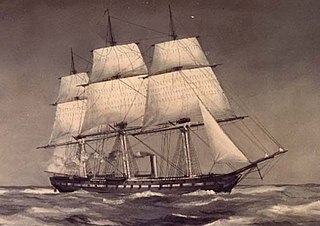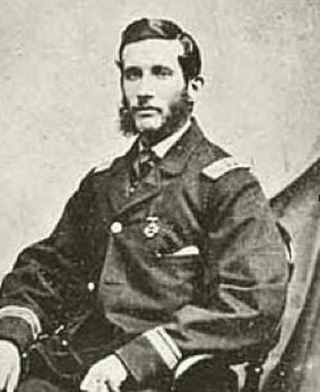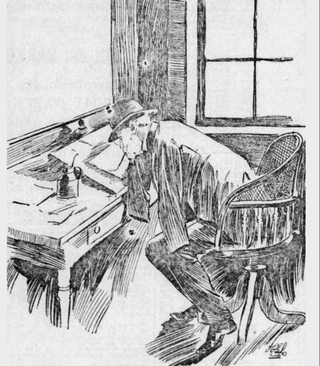
USS Monitor was an ironclad warship built for the United States Navy during the American Civil War and completed in early 1862, the first such ship commissioned by the Navy. Monitor played a central role in the Battle of Hampton Roads on 9 March under the command of Lieutenant John L. Worden, where she fought the casemate ironclad CSS Virginia to a stalemate. The design of the ship was distinguished by its revolving turret, which was designed by American inventor Theodore Timby; it was quickly duplicated and established the monitor class and type of armored warship built for the American Navy over the next several decades.

USS Minnesota was a wooden steam frigate in the United States Navy. Launched in 1855 and commissioned eighteen months later, the ship served in east Asia for two years before being decommissioned. She was recommissioned at the outbreak of the American Civil War and returned to service as the flagship of the North Atlantic Blockading Squadron.

USS Santee was a wooden-hulled, three-masted sailing frigate of the United States Navy. She was the first U.S. Navy ship to be so named and was one of its last sailing frigates in service. She was acquired by the Union Navy at the start of the American Civil War, outfitted with heavy guns and a crew of 480, and was assigned as a gunboat in the Union blockade of the Confederate States. She later became a training ship then a barracks ship for the U.S. Naval Academy.

The first USS Rhode Island was a side-wheel steamer in the United States Navy, commissioned in 1861.

Stephen Bleecker Luce was a U.S. Navy admiral. He was the founder and first president of the Naval War College, between 1884 and 1886.From 1909 to 1910 he was vice president,from 1910 to 1911 president of the Aztec Club of 1847.

USS Wabash was a steam screw frigate of the United States Navy that served during the American Civil War. She was based on the same plans as Colorado. Post-war she continued to serve her country in European operations and eventually served as a barracks ship in Boston, Massachusetts, and was sold in 1912.

Commodore William Nicholson Jeffers was a U.S. Navy officer of the 19th century. He took part in combat operations during the Mexican–American War and the American Civil War, and during the 1870s and early 1880s served as Chief of the Bureau of Ordnance.

The Union Navy was the United States Navy (USN) during the American Civil War, when it fought the Confederate States Navy (CSN). The term is sometimes used carelessly to include vessels of war used on the rivers of the interior while they were under the control of the United States Army, also called the Union Army.

John Jones was a United States Navy sailor and a recipient of America's highest military decoration — the Medal of Honor — for his actions in the American Civil War.

George E. Read (1838–1910) was an American sailor who received the Medal of Honor for valor in action during the American Civil War.

Thomas H. Cripps was a native of Philadelphia, Pennsylvania, who became a U.S. Medal of Honor winner during the American Civil War. While serving in the Union Navy as a quartermaster aboard the USS Richmond, he operated one of that's ship's guns under heavy enemy fire for two hours during the Battle of Mobile Bay, Alabama on August 5, 1864, helping to damage the CSS Tennessee and destroy artillery batteries of the Confederate States Army at Fort Morgan, even as the enemy's shell and shot damaged his ship and killed several of his fellow crewmen. For those actions, he was awarded his nation's highest honor for bravery on December 31, 1864.

Hugh Logan was a Captain of the Afterguard in the Union Navy and a Medal of Honor recipient for his actions in the American Civil War.

John Pyne Bankhead (1821–1867) was an officer in the United States Navy who served during the American Civil War, and was in command of the ironclad USS Monitor when it sank in 1862. He went on to command three other ships.
George F. Brady was a sailor in the United States Navy who received the Medal of Honor for his heroic actions during the Spanish–American War.

Louis Napoleon Stodder was a U.S. Navy officer who served in the American Civil War as acting master on the famous USS Monitor when it fought the Merrimack at Hampton Roads on March 8–9, 1862. He is also noted for his heroic efforts in the final hours before Monitor sank in a violent storm at sea off Cape Hatteras that same year. He later commanded USS Adela and served in the East Gulf Blockading Squadron. After the Civil War, he was promoted to captain and served with distinction, commanding other vessels and served in other capacities. He continued serving in the Navy until 1902. When he retired, Stodder lived out the remainder of his years in New York.
Peter Williams was a Union Navy sailor in the American Civil War who received the U.S. military's highest decoration, the Medal of Honor. He earned the award for steering USS Monitor throughout the Battle of Hampton Roads, the first combat between ironclad warships in history.

Luke M. Griswold was a recipient of the Medal of Honor. He was awarded the Medal of Honor "for extraordinary heroism in action while serving on board the U.S.S. Rhode Island which was engaged in saving the lives of the officers and crew of the U.S.S. Monitor, 30 December 1862 near Cape Hatteras, North Carolina. Participating in the hazardous rescue of the officers and crew of the sinking Monitor, Ordinary Seaman Griswold, after rescuing several of the men, became separated in a heavy gale with other members of the cutter that had set out from the Rhode Island, and spent many hours in the small boat at the mercy of the weather and high seas until finally picked up by a schooner 50 miles east of Cape Hatteras."

Seaman George Moore was a Union Navy sailor in the American Civil War and a recipient of the U.S. military's highest decoration, the Medal of Honor.
Charles H. Smith was a Union Navy sailor in the American Civil War and a recipient of the U.S. military's highest decoration, the Medal of Honor, for his actions aboard the USS Rhode Island.

Lewis Augustine Horton was an American sailor in the Union Navy during the American Civil War and recipient of the Medal of Honor.















